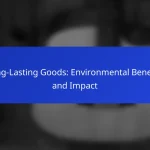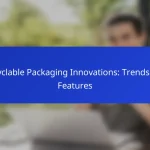What are the best materials for durability and longevity?
The best materials for durability and longevity are those that resist wear, corrosion, and environmental damage. Key options include stainless steel, carbon fiber, high-density polyethylene, aluminum alloys, and concrete, each offering unique benefits for various applications.
Stainless steel
Stainless steel is renowned for its resistance to rust and corrosion, making it ideal for outdoor and marine applications. It is commonly used in kitchen appliances, medical instruments, and construction materials due to its strength and aesthetic appeal.
When selecting stainless steel, consider grades like 304 for general use and 316 for environments exposed to saltwater. Regular maintenance can enhance its lifespan, but it generally requires minimal upkeep.
Carbon fiber
Carbon fiber is a lightweight yet incredibly strong material, often used in aerospace, automotive, and sporting goods. Its high tensile strength allows for thinner designs without sacrificing durability, which is crucial in high-performance applications.
However, carbon fiber can be more expensive than traditional materials. It’s essential to evaluate the specific requirements of your project, as its brittleness can be a drawback in certain conditions.
High-density polyethylene
High-density polyethylene (HDPE) is a versatile plastic known for its impact resistance and durability. It is commonly used in containers, piping, and outdoor furniture, where it withstands harsh weather conditions without degrading.
HDPE is also resistant to chemicals, making it suitable for industrial applications. Consider its recyclability and low maintenance needs when selecting materials for projects focused on sustainability.
Aluminum alloys
Aluminum alloys are lightweight and resistant to corrosion, making them popular in the aerospace and automotive industries. They offer a good strength-to-weight ratio and can be easily fabricated into various shapes.
When choosing aluminum alloys, consider the specific alloy series for your application, as different compositions provide varying levels of strength and corrosion resistance. Regular inspections can help maintain their integrity over time.
Concrete
Concrete is a widely used construction material known for its compressive strength and durability. It is suitable for foundations, roads, and structures that require longevity and resistance to environmental factors.
To enhance concrete’s durability, consider additives like fly ash or silica fume, which can improve its resistance to cracking and weathering. Proper curing techniques are essential to maximize its lifespan and performance in various applications.
How does climate affect durability and longevity?
Climate significantly influences the durability and longevity of materials and structures. Factors such as humidity, temperature fluctuations, and UV radiation exposure can accelerate wear and tear, impacting the lifespan of products and buildings.
Impact of humidity
Humidity levels can lead to moisture-related issues, such as mold growth and material degradation. High humidity can cause wood to swell and warp, while low humidity may lead to cracking in materials like concrete and plaster.
To mitigate humidity’s effects, consider using moisture-resistant materials in high-humidity areas. Regular maintenance, such as sealing and treating surfaces, can also prolong durability.
Effects of temperature fluctuations
Temperature fluctuations can cause materials to expand and contract, leading to stress and potential failure. For instance, metals may warp, while plastics can become brittle in extreme cold.
Choosing materials designed to withstand temperature changes is crucial, especially in regions with significant seasonal variations. Insulation and climate control can help maintain stable conditions, reducing the impact of temperature shifts.
UV radiation exposure
UV radiation can degrade materials over time, causing fading, brittleness, and loss of structural integrity. Commonly affected materials include plastics, paints, and fabrics, which can break down when exposed to direct sunlight.
To enhance longevity, select UV-resistant materials for outdoor applications. Regular maintenance, such as applying protective coatings, can also help shield surfaces from harmful UV rays.
What are the top durable products available?
Some of the most durable products on the market include Leatherman multi-tools, YETI coolers, Pelican cases, and Dyson vacuums. These items are known for their robust construction, reliability, and ability to withstand harsh conditions.
Leatherman multi-tools
Leatherman multi-tools are designed for versatility and durability, making them ideal for outdoor enthusiasts and everyday users alike. Crafted from high-quality stainless steel, these tools often feature a variety of functions, such as pliers, knives, and screwdrivers, all in one compact design.
When choosing a Leatherman, consider the specific tools you need. Models like the Wave Plus or the Charge TTi offer a good balance of features and portability. Regular maintenance, such as cleaning and oiling the joints, can extend the lifespan of your multi-tool.
YETI coolers
YETI coolers are renowned for their exceptional insulation and rugged construction, making them a favorite for camping, fishing, and tailgating. These coolers are built with rotomolded polyethylene, which provides resistance to impact and UV rays.
When selecting a YETI cooler, consider factors like size and insulation performance. The Tundra series, for example, is designed to keep ice for several days, making it suitable for extended trips. Investing in a YETI cooler can be worthwhile for those who frequently spend time outdoors.
Pelican cases
Pelican cases are engineered to protect sensitive equipment from extreme conditions, including water, dust, and impact. Made from high-impact polymer, these cases are often used by professionals in photography, military, and industrial fields.
When choosing a Pelican case, assess the size and level of protection required for your gear. Many models come with customizable foam inserts to ensure a snug fit for your items. Regularly check seals and latches to maintain waterproof capabilities.
Dyson vacuums
Dyson vacuums are known for their powerful suction and innovative design, making them a popular choice for maintaining clean homes. These vacuums utilize cyclone technology to capture microscopic dust and allergens effectively.
When selecting a Dyson vacuum, consider whether you need a cordless model for convenience or a corded version for extended cleaning sessions. Regularly emptying the dust bin and cleaning filters can help maintain optimal performance and prolong the life of your vacuum.
How to maintain products for longevity?
Maintaining products for longevity involves regular care and attention to ensure they remain functional and visually appealing over time. Key practices include cleaning, proper storage, and routine inspections to identify any potential issues early.
Regular cleaning
Regular cleaning is essential for preserving the condition of your products. Dust, dirt, and grime can accumulate and lead to wear and tear if not addressed. Depending on the material, cleaning may involve simple dusting or using specific cleaners that are safe for the product.
For example, electronics should be wiped with a microfiber cloth to avoid scratches, while fabrics may need gentle washing according to care labels. Establish a cleaning schedule to ensure consistency, aiming for at least monthly maintenance.
Proper storage
Proper storage is crucial for extending the life of your products. Store items in a cool, dry place away from direct sunlight to prevent fading and deterioration. Use protective cases or covers when applicable, especially for delicate items.
For instance, storing shoes in their original boxes or breathable bags can help maintain their shape and condition. Avoid overcrowding storage spaces, as this can lead to damage from pressure or friction.
Routine inspections
Routine inspections help catch potential problems before they escalate. Regularly check products for signs of wear, such as fraying, rust, or cracks. This proactive approach allows for timely repairs or replacements, which can save money in the long run.
Set a reminder to inspect items at least every six months. Create a checklist of key areas to examine, ensuring you cover all aspects of the product’s condition. Address any issues immediately to maintain functionality and appearance.
What are the warranties for durable products?
Warranties for durable products typically cover defects in materials and workmanship for a specified period. These warranties can range from a few years to a lifetime, depending on the product and manufacturer.
Types of Warranties
There are generally two main types of warranties: limited and full. A limited warranty may cover only specific parts or defects, while a full warranty often includes comprehensive coverage for repairs or replacements. Understanding the type of warranty can help consumers make informed purchasing decisions.
Some products may also come with extended warranties, which can be purchased separately. These extended warranties often provide additional coverage beyond the standard warranty period, but they may come with extra costs.
What to Look for in a Warranty
When evaluating a warranty, consider the duration, coverage details, and any exclusions. Look for warranties that clearly outline what is included and what is not, as this can prevent misunderstandings later. It’s also beneficial to check if the warranty is transferable, which can add value if you decide to sell the product.
Additionally, pay attention to the process for making a claim. A straightforward claims process can save time and frustration, while a complicated one may deter you from seeking repairs or replacements.
Common Warranty Pitfalls
One common pitfall is assuming that all damages are covered. Many warranties exclude issues caused by misuse, accidents, or normal wear and tear. Always read the fine print to understand these limitations.
Another mistake is neglecting to register the warranty. Some manufacturers require registration within a certain timeframe to activate the warranty. Failing to do so could void your coverage.






